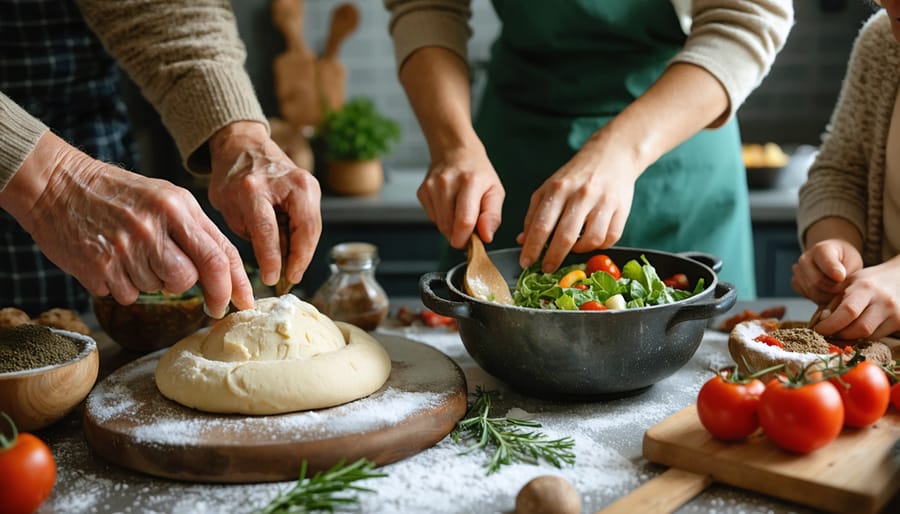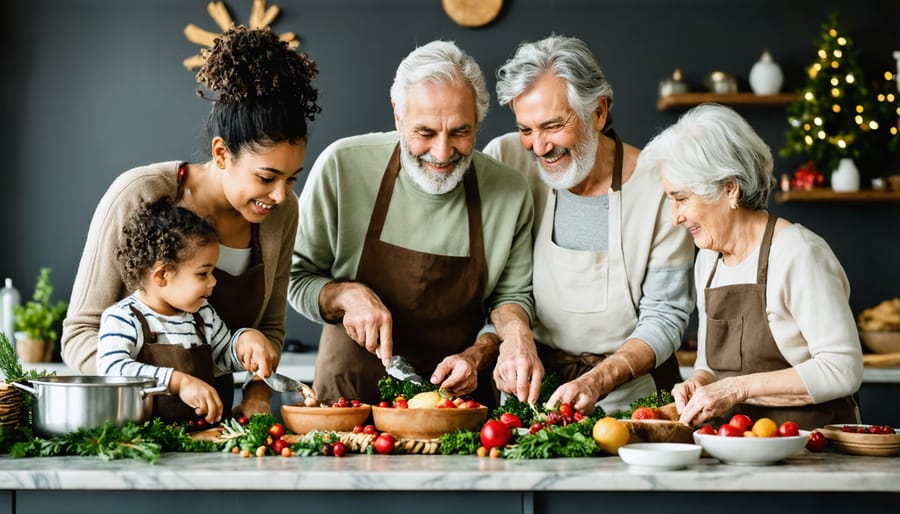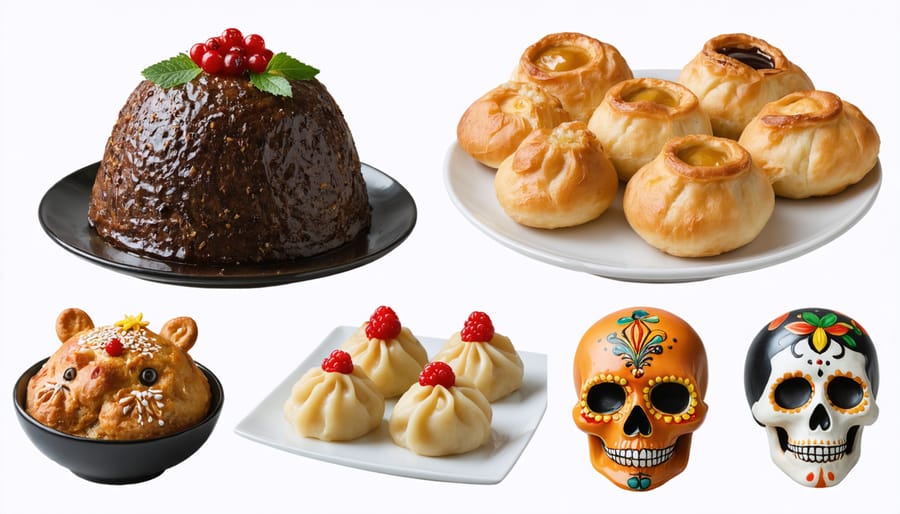
In the heart of every family kitchen lies a story written in well-worn recipe cards, beloved cooking rituals, and the comforting aromas that transport us through generations. Culinary traditions serve as more than just instructions for preparing meals – they’re the invisible threads that weave together our cultural identity, family histories, and most cherished memories. From the way Grandma pinches her pierogi dough to the secret spice blend that makes Mom’s holiday roast unforgettable, these practiced hands and time-honored techniques carry forward the wisdom, love, and cultural heritage of those who came before us.
Today, as our lives become increasingly fast-paced and globally connected, these culinary traditions take on new significance. They ground us in our roots while allowing us to branch out and create our own meaningful food rituals. Whether you’re preserving your family’s time-honored recipes, incorporating traditions from other cultures, or establishing new customs that reflect your modern lifestyle, the art of culinary tradition continues to evolve while remaining fundamentally about connection, celebration, and the simple joy of sharing a meal with those we love.
The Heart of Holiday Celebrations: Food That Tells Our Story

Family Recipes as Time Capsules
Every dog-eared recipe card and sauce-stained cookbook page tells a story that goes far beyond ingredients and cooking instructions. These treasured family recipes are like time capsules, preserving precious memories of Sunday dinners at Grandma’s house, holiday gatherings, and quiet moments in the kitchen learning from loved ones.
When we recreate great-grandmother’s pierogi recipe or follow Mom’s handwritten instructions for her signature lasagna, we’re doing more than preparing a meal – we’re keeping family histories alive. Each recipe carries whispers of immigration stories, celebrations, and the resilient spirit of those who came before us.
Think of your own family’s recipe collection. Maybe it’s Aunt Maria’s perfectly spiced empanadas or your grandfather’s traditional matzo ball soup. These dishes aren’t just about taste; they’re about identity, belonging, and the invisible threads that connect generations. Even the little notes in the margins – “add more butter” or “let rest for exactly 30 minutes” – tell us something about our ancestors’ personalities and the care they took in passing down their culinary wisdom.
The Evolution of Holiday Dishes
Like cherished family photos, holiday dishes tell stories that span generations, evolving while keeping their heart intact. I remember how my grandmother’s traditional stuffing recipe gradually welcomed new ingredients over the years – cranberries for brightness, pecans for crunch – yet somehow maintained that familiar comfort we all craved each Thanksgiving.
Today’s holiday tables reflect our increasingly connected world. Families are adapting ancestral recipes to accommodate dietary preferences and ingredient availability without losing their cultural essence. A gluten-free version of Italian Christmas panettone or a vegan take on Polish pierogi shows how traditions can flex while preserving their soul.
This evolution often happens naturally, as each generation adds its own touch. Some families might swap heavy cream for coconut milk in their holiday bread pudding, while others might incorporate quinoa into their traditional stuffing. These thoughtful adaptations often create new traditions that honor the past while embracing the present.
What matters most is keeping the spirit of these dishes alive – the memories they evoke, the stories they tell, and the way they bring people together, generation after generation.

Festive Flavors Around the Globe
European Holiday Tables
The magic of European holiday tables lies in their ability to tell stories through generations of cherished recipes. In Italy, Christmas Eve brings the Feast of the Seven Fishes, where families gather to share an array of seafood dishes, from salt cod to octopus salad. The tradition stems from Catholic customs of abstaining from meat on holy days, but it’s evolved into a celebrated cultural phenomenon that brings loved ones together.
Moving north to Scandinavia, the julbord (Christmas table) features an impressive spread of pickled herring, gravlax, and meatballs, accompanied by warming glasses of glögg. In Germany, the aroma of freshly baked stollen and lebkuchen fills homes during the festive season, while Christmas markets buzz with the scent of roasted chestnuts and mulled wine.
British holiday tables wouldn’t be complete without Christmas pudding, a rich dessert traditionally stirred from east to west to honor the journey of the Three Wise Men. The French celebrate with their Réveillon feast, serving delicacies like oysters, foie gras, and the iconic Bûche de Noël.
Easter brings its own special dishes across Europe. Greeks prepare tsoureki, a sweet bread decorated with red-dyed eggs, while in Poland, families gather for święconka, blessing baskets filled with eggs, bread, and traditional Easter sausage. These customs don’t just feed our bodies; they nourish our connections to heritage and family, making each holiday gathering truly meaningful.
Asian Celebration Foods
Throughout Asia, celebration foods are woven into the fabric of cultural identity, creating moments of joy and connection that span generations. In China, the Lunar New Year brings families together over steaming plates of longevity noodles and plump dumplings, each carefully crafted to symbolize prosperity and good fortune. I remember watching my friend’s grandmother teaching her the art of dumpling folding – a tradition she now shares with her own daughter.
Japanese festivities often feature osechi ryori during New Year celebrations, with each beautifully arranged box containing dishes like black soybeans for good health and sweet rolled omelet for scholarship and learning. In Korea, the harvest festival of Chuseok wouldn’t be complete without songpyeon, half-moon shaped rice cakes filled with sweet sesame seeds or red beans.
Vietnamese Tet celebrations bring bánh chưng to the table – sticky rice cakes wrapped in banana leaves that tell stories of ancestral devotion. In India, the festival of Diwali sparkles with treats like coconut ladoo and crispy jalebi, while families gather to share stories and sweets.
These celebration foods do more than satisfy hunger – they’re vessels of cultural memory and family bonds. Whether it’s the careful preparation of mooncakes during Mid-Autumn Festival or the collective joy of making kimchi with loved ones, these traditions create lasting connections that transcend generations.
Americas’ Festive Fare
From the cozy warmth of Canadian butter tarts to the vibrant flavors of Brazilian Rabanada, the Americas offer a rich tapestry of holiday food traditions that bring families together across two continents. In the United States, Thanksgiving remains the ultimate celebration of traditional fare, with golden-brown turkeys taking center stage alongside regional specialties like Southern cornbread dressing or New England cranberry sauce.
Moving north, Canadian holiday tables often feature tourtière, a savory meat pie that’s particularly beloved in Quebec during the Christmas season. The sweet aroma of maple syrup finds its way into countless holiday treats, reflecting the country’s natural bounty.
In Mexico, the December calendar fills with posadas, where tamales wrapped in corn husks and steaming cups of champurrado (thick hot chocolate) warm both bodies and spirits. The tradition of making tamales together, or tamaladas, has become a cherished pre-holiday ritual that brings multiple generations into the kitchen.
South American festivities showcase unique traditions like Peru’s hot chocolate and panetón gatherings on Christmas Eve, while in Argentina, families gather for asados (barbecues) featuring chorizo and chimichurri sauce. Brazilian homes fill with the scent of bacalhau (salt cod) during the holidays, a Portuguese influence that’s become deeply embedded in local culture.
What makes these traditions special isn’t just the food itself, but the stories and memories created around these shared meals, passed down through generations like precious family heirlooms.
Creating Your Own Food Traditions
Blending Old and New
Finding the perfect balance between honoring traditional recipes and creating new family favorites is like weaving a beautiful culinary tapestry. The key is to approach change thoughtfully while preserving the heart of your family’s food heritage.
Start by identifying the core elements that make your traditional dishes special – perhaps it’s a specific spice blend your grandmother used or the way your mom folded dumplings. Keep these elements as your foundation while considering modern adaptations. For instance, if your family’s traditional lasagna recipe takes six hours to prepare, consider making a batch on weekends and freezing portions for busy weeknights.
Don’t be afraid to introduce new ingredients or techniques that align with contemporary dietary preferences. If some family members are vegetarian, create plant-based versions of traditional dishes alongside the original recipes. This inclusive approach ensures everyone can participate in family food traditions.
Document your journey by creating a digital recipe collection that includes both traditional recipes and your modern interpretations. Take photos, record video tutorials, and write down the stories behind each dish. This helps preserve the heritage while embracing innovation.
Remember that traditions evolve naturally over time. What matters most is maintaining the spirit of connection and love that food traditions represent. Whether you’re tweaking a century-old recipe or starting a completely new tradition like monthly international dinner nights, focus on creating meaningful experiences that your family will cherish for generations to come.
Making Memories in the Kitchen
The kitchen becomes truly magical when multiple generations come together to prepare holiday meals. Creating lasting kitchen memories is easier than you might think, and the holiday season presents the perfect opportunity to start.
Consider assigning age-appropriate tasks to everyone in the family. Little ones can help measure ingredients, mix batters, or decorate cookies. Older children might enjoy learning knife skills under supervision or mastering family recipes alongside adults. Even teenagers who seem uninterested might surprise you when given responsibility for an entire dish.
Make the experience fun by turning on holiday music, sharing stories about past celebrations, or starting friendly competitions like who can fold the most perfect dumpling. Document these precious moments by taking photos or videos, and encourage family members to jot down recipe notes in a dedicated journal.
Create stations in your kitchen where different generations can work together. Perhaps grandma can teach the art of pie crimping at the counter while dad and the kids prep vegetables at the table. These shared experiences not only make the cooking process more enjoyable but also ensure that cherished recipes and techniques are passed down through generations.
Remember, perfection isn’t the goal – it’s about togetherness, learning, and creating memories that will be treasured for years to come.
Preserving Traditions in a Modern World
In our fast-paced world, preserving culinary traditions can feel like swimming against the tide. Yet, these cherished food customs are more than just recipes – they’re the threads that weave our family stories and cultural identity together. As someone who struggled to maintain my grandmother’s holiday cooking traditions while juggling a busy career, I’ve discovered that keeping these traditions alive requires creativity and adaptability rather than rigid adherence to the past.
Start by identifying which food traditions matter most to your family. Perhaps it’s your aunt’s special pierogi recipe or the elaborate Diwali sweets your mother makes. Document these recipes and the stories behind them, whether through videos, photos, or a family cookbook. This documentation becomes particularly valuable during mindful holiday celebrations, when we can pause to appreciate the significance of each dish.
Modern technology can be an unexpected ally in preserving traditions. Use video calls to cook virtually with relatives, sharing tips and techniques across distances. Schedule monthly cooking sessions with children, turning tradition into a regular family activity rather than reserving it only for special occasions. Many busy families find success in “batch cooking” traditional dishes, freezing portions for future meals while maintaining authentic preparation methods.
Consider creating a “tradition with a twist” approach. While keeping the essence of traditional recipes, adapt them to fit contemporary dietary preferences or time constraints. For instance, using a slow cooker for traditionally long-simmered dishes or preparing components in advance for complex recipes. The key is maintaining the spirit of the tradition while making it sustainable in modern life.
Remember that preservation doesn’t mean perfection. Sometimes, shortcuts are necessary, and that’s okay. What matters most is keeping the connection to our cultural heritage alive through food, even if the execution looks different from generation to generation.

As we wrap up our culinary journey, it’s clear that food traditions are so much more than just recipes passed down through generations – they’re the threads that weave our family stories, cultural identities, and shared memories together. I’m reminded of my grandmother’s kitchen, where the simple act of making pierogi became a monthly ritual that brought three generations together, sharing not just techniques but also family histories and life lessons.
In our fast-paced modern world, preserving these food traditions might seem challenging, but it’s more important than ever. Each time we prepare a traditional dish, we’re not just cooking – we’re keeping cultural heritage alive and creating connections that span across time and distance. Whether it’s documenting family recipes in a digital cookbook, teaching children the significance behind holiday dishes, or hosting cultural cooking gatherings with friends, every effort counts.
Remember that traditions aren’t static – they evolve and adapt while maintaining their core essence. Don’t be afraid to put your own spin on traditional recipes or blend different cultural influences. What matters most is maintaining the spirit of connection and celebration that food traditions represent.
By sharing our culinary heritage with others, we create bridges between cultures and generations, fostering understanding and appreciation for diverse traditions. Let’s commit to keeping these precious food traditions alive, one meal at a time, ensuring that future generations can taste, experience, and share in the rich tapestry of our collective culinary heritage.



